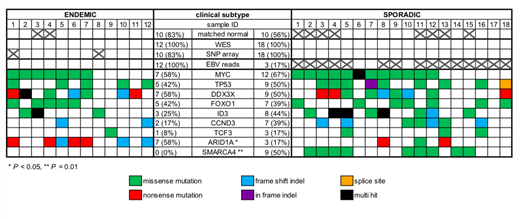Abstract
Introduction
Burkitt Lymphoma (BL) is a highly aggressive hematological malignancy that originates from germinal center B-cells, is characterized by IG/MYC translocation, and affects both children and adults. Clinical and biological differences have been noted between endemic BL, which occurs in equatorial Africa and is virtually always associated with Epstein-Barr virus (EBV) infection, and sporadic BL that is infrequently associated with EBV. BL is highly curable using an aggressive chemotherapy regimen, but the intensive supportive care required to manage the toxicities of this treatment precludes its use for most patients with endemic BL, resulting in poorer survival for those patients. Although previous genetic studies have identified recurrent mutations in BL (including alterations in ID3 and its downstream targets TCF3 and CCND3), endemic BL has not been as well characterized and the extent of differences between sporadic and endemic BL (and their potential relation to pathogenesis and response to therapy) is not yet clear. Therefore, more extensive genomic characterization of both sporadic and endemic BL is needed to provide insight into tumor biology and to identify novel therapeutic targets that can be utilized to provide less toxic treatments.
Methods
We interrogated frozen tumor and matched normal blood samples from a cohort of 30 pediatric BL cases, 12 of which were collected from Uganda and 18 from Texas Children's Cancer Center (Houston, TX). Whole exome sequencing (WES) and copy number analysis were performed on the Illumina platform using the OmniExpress array and VCrome 2.1 WES capture reagent and analyzed utilizing the Baylor College of Medicine Human Genome Sequencing Center bioinformatic pipeline. A median of 135x average coverage and >97% of targeted bases with at least 20x coverage was observed for WES.
Results
WES revealed a median of 46 nonsilent somatic mutations per case for endemic BL (range 19-207), and 32 per case for sporadic BL (range 13-119). Evidence of the EBV genome was detected in all endemic BL samples and 3/18 (17%) of sporadic BL cases. Mutations were found in genes known to be frequently mutated in BL, including MYC in 7/12 (58%) of endemic cases and 12/18 (67%) of sporadic cases and TP53 in 5/12 (42%) and 9/18 (50%), respectively. Of note, mutations in DDX3X (7/12 [58%] endemic, 9/18 [50%] sporadic) and FOXO1 (5/12 [42%] endemic, 7/18 [39%] sporadic) were identified frequently in our cohort. As previously described, the ID3 pathway was more frequently targeted by mutations in sporadic BL: ID3 in 8/18 (44%) sporadic cases vs 3/12 (25%) endemic, TCF3 in 3/18 (17%) vs. 1/12 (8%), and CCND3 in 7/18 (39%) vs 2/12 (17%), respectively. Mutations in the SWI/SNF chromatin-remodeling genes ARID1A and SMARCA4 have been reported to occur in BL in a mutually exclusive fashion. In our cohort, mutations in SMARCA4 were exclusive to sporadic cases (9/18, 50%) and not found in endemic tumors (P = 0.01). Conversely, ARID1A mutations were much more frequent in endemic cases (7/12, 58%) as compared to sporadic ones (3/18, 17%) (P < 0.05). Only one sporadic case was found to have both genes mutated. Copy number analysis did not reveal recurrent focal copy number deletions. Amplification of 13q31.2 - q32.2 was detected in sporadic cases (4/18, 22%) but not in endemic cases, while focal amplification of 7p14.1 (3/10, 30%) and 14q11.2 (4/10, 40%) were exclusive to endemic tumors.
Conclusions
These findings provide novel insight into the landscapes of genomic alterations in pediatric endemic and sporadic BL. Our data confirm the recurrence of mutated genes previously associated with BL and highlight differences between endemic and sporadic BL, most notably, the exclusivity of SMARCA4 mutations in sporadic BL cases in this cohort. The recurrence of mutations in ARID1A and SMARCA4 emphasizes the critical role of these SWI/SNF proteins in BL. More extensive molecular studies (whole genome and transcriptome sequencing) of this cohort are ongoing and may reveal additional differences between endemic and sporadic BL. Additional studies will be required to more precisely assess the frequency of these alterations in BL and their link to clinical features of the disease, as well as the biological relevance of the BL genes identified through these genomic analyses.
No relevant conflicts of interest to declare.
Author notes
Asterisk with author names denotes non-ASH members.


This feature is available to Subscribers Only
Sign In or Create an Account Close Modal